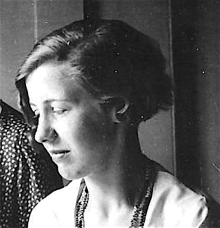
Betty Scott [also known as Betty Pierce] was born in Palmers Moor, Iver, Buckinghamshire, England, on 7 July 1904 and as a child, moved with her family to Kensington, London. From 1923 to 1928 she attended the Architectural Association in London, where she won the Second Year Prize for Art (1925) and received the Victory Scholarship awarded by the Royal Institute of British Architects. In 1930 she went into partnership with Norah Aiton (1904-1989), a fellow student at the AA. The office of Aiton & Scott was located at 183 Sloane Street, Chelsea, London
The first, and, possibly, most significant project by the practice was the Aiton & Co. factory office near Derby, England, which they designed for John Arthur Aiton, Norah Aiton's father, in 1930-31.
Later projects by Aiton & Scott included other factory offices, a printing works, a crematorium, a church, a private zoo, and houses for private clients. They also designed furniture. A photograph of a cocktail bar, designed by Aiton & Scott is illustrated in 'Decorative Art' 1933 (p.54).
Scott was elected an Associate of the Royal Institute of British Architects (ARIBA) in 1931. In December 1931 she married Stephen Rowland Pierce (1896-1966), an architect, and was subsequently known as Betty Pierce. Later work by her included architectural contributions to films including Henry V (1944) and Hamlet (1948), and a house designed for herself at 44 Aubrey Walk, Holland Park, London in 1968. She died in Chelsea, London on 27 September 1983.
Note: Betty Scott maybe confused with Elisabeth Whitworth Scott (1898-1972), architect of the Shakespeare Memorial Theatre in Stratford-upon-Avon
AA Women in Architecture 1917-2017. Edited by Elizabeth Darling and Lynne Walker. London: Architectural Association and the authors, 2017
Powers, Alan. Modern. The Modern Movement in Britain. London: Merrell, 2005 pp.44-45
Walker, Lynne. ‘The Forgotten Architecture of Vision: Aiton & Scott’s Factory Office for Aiton & Co.’, Derby, 1930-1’. Twentieth Century Architecture. The Journal of the Twentieth Century Society [Industrial Architecture Special Issue] no.1, Summer 1994 pp.23-30